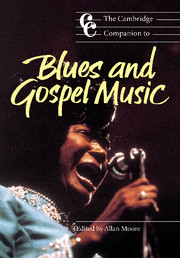Book contents
- Frontmatter
- 1 Surveying the field: our knowledge of blues and gospel music
- 2 Labels: identifying categories of blues and gospel
- 3 The development of the blues
- 4 The development of gospel music
- 5 Twelve key recordings
- 6 “Black twice”: performance conditions for blues and gospel artists
- 7 Vocal expression in the blues and gospel
- 8 The Guitar
- 9 Keyboard techniques
- 10 Imagery in the lyrics: an initial approach
- 11 Appropriations of blues and gospel in popular music
- Notes
- Bibliography
- Selected discography and videography
- Index
- Plate section
7 - Vocal expression in the blues and gospel
Published online by Cambridge University Press: 28 September 2011
- Frontmatter
- 1 Surveying the field: our knowledge of blues and gospel music
- 2 Labels: identifying categories of blues and gospel
- 3 The development of the blues
- 4 The development of gospel music
- 5 Twelve key recordings
- 6 “Black twice”: performance conditions for blues and gospel artists
- 7 Vocal expression in the blues and gospel
- 8 The Guitar
- 9 Keyboard techniques
- 10 Imagery in the lyrics: an initial approach
- 11 Appropriations of blues and gospel in popular music
- Notes
- Bibliography
- Selected discography and videography
- Index
- Plate section
Summary
The human voice is like a thumb print, aurally and spectrally identifiable. The extraordinarily affecting voices of gospel and blues singers have, in their recordings, given us access to those singers' deepest emotions and, in so doing, allowed us to glimpse their individual and common struggles for dignity and freedom in an often terrifyingly hostile environment. Unlike other instruments, the voice emanates from and is played inside the body. In this respect it is unique. Contemporary understanding of “voice” must therefore incorporate the connection between the personality, physicality, spirituality, individual experience and social history of each singer. For the listener, description of these singers' vocal production is fraught with difficulties not least because the plethora of interpretations reflect individual singers' personal expression, as well as their commonality of experience in African American culture and society pre- and post-slavery. My own responses to this work emerge from my love of these musics and singers, and are subject also to my own cultural understanding and experience as both listener and singer/teacher. There are so many elements to “voice” that this brief chapter may only scratch the surface of the many extraordinary vocal performances in these genres. Each individual “voice” has its own story, its own personal history. I have focused on particular singers and examples in an attempt to raise some of the aspects of these relationships, personally, stylistically and in the context of their culture and society, but the voices I omit are by no means less important. Their omission is due to constraints of space and does not represent any aesthetic judgment on my own part.
- Type
- Chapter
- Information
- The Cambridge Companion to Blues and Gospel Music , pp. 102 - 115Publisher: Cambridge University PressPrint publication year: 2003
- 2
- Cited by

